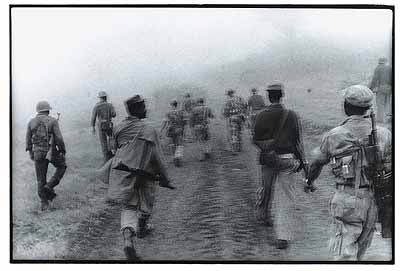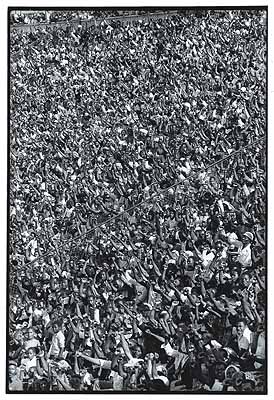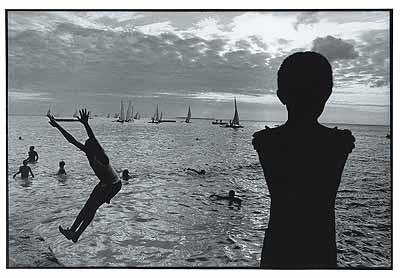
Iluminando Vidas - Fotografia Moçambicana 1950–2001
Ricardo Rangel & the Next Generation
Rui Assubuji » Luís Basto » José Cabral » Joel Chiziane » João Costa » Alexandre Fenías » Martinho Fernando » Albino Mahumana » Ferhat Vali Momade » Alfredo Mueche » Kok Nam » Alfredo Paco » Ricardo Rangel » Sérgio Santimano » Naíta Ussene »
Exhibition: 13 Apr – 19 May 2002
CentrePasquArt - Photoforum
Seevorstadt 71-75 Fauburg du Lac
2502 Biel Bienne
Photoforum Pasquart
Seevorstadt 71, Faubourg du Lac
2502 Biel Bienne
032-322 44 82
info@photoforumpasquart.ch
www.photoforumpasquart.ch
Wed-Sun 12-18

Contact: Bruno Z'Graggen
CH-Zurich, Phone/Fax +41 (0)1 463 23 07
www.iluminandovidas.org
bruno_zgraggen@dplanet.ch
Iluminando Vidas, Shed Light on Life, is the title of the homage by Calane da Silva to his friend and companion Ricardo Rangel, now 78, who is the forerunner and doyen of contemporary Mozambican photography. The Portuguese word "iluminar" contains the word "light", which is an essential element of photography. It has two levels of meaning: to illuminate an object and, in the figurative sense, to shed light on something and elucidate it. A festive and poetic nuance accompanies both meanings: give light and lustre to something and lend it a "bright, dazzling tone".
The title "Iluminando Vidas" goes right to the heart of Ricardo Rangel’s creative work, and yet it does even more than that. For a long time now, it has been the main theme of the generation of photographers who came after him, a sort of programme and credo of Mozambican photography. It is represented here in works by Ricardo Rangel and fourteen other photographs from his milieu.
Mozambican photography is photo reporting with commitment. It depicts people with respect and focuses on them with dignity. Characterised by empathy and precision, it tells of many-facetted worlds and denounces injustice. It encompasses the period of the "tempo colonial", the 50’s, the war of independence and the separation from Portugal in 1975, the civil war, the peace agreement of 1992 and the departure into a new and more promising future. Its approach renders it immune against being highjacked by powerful interest groups. It has become a moral authority and helps create an identity in post-colonial Mozambique.
Along side the print media, there are two institutions which support the photographic tradition: the photography federation Associacão Moçambicana de Fotografia (AMF) and Centro de Formação Fotográfica (CFF), which from 2001 onwards has been called the Centro de Documentação e Formação Fotográfica (CDFF). Both are exceptional in the African context and were founded in the capital city of Maputo only a few years after independence at the time of the civil war.
AMF entered onto the public stage in 1981, presenting an initial synopsis exhibition called "Moçambique. A Terra e os Homens" ("Mozambique. The Country and the People"). One year later, the AMF opened a gallery in the centre of Maputo. The gallery is available to artists from other genres and has become a meeting ground of Mozambican culture.
The CFF was founded in 1984 under the direction of Ricardo Rangel, and he still manages it today. There was a lack of qualified personnel in all areas in the new country at the time, because the Portuguese had fled from Moçambique when colonial rule ended. About a dozen people work today at the CDFF. The centre has good infrastructure including two laboratories and a studio. Photographic skills for communication and documentation and the photojournalism trade are taught at the centre. The archive holds the country’s visual memory.
"Iluminando Vidas" is the first extensive display of contemporary Mozambican photography to be presented in Europe since the end of the civil war. In the world of African photography, on the other hand, Mozambican photography has enjoyed an excellent reputation for many years in the "images du réel" genre, and Ricardo Rangel’s work is known around the world. His series on prostitutes in the capital’s nocturnal harbour district ("Pão nosso de cada noite") from the 60’s and 70’s is his most outstanding work. Two highlights of the international recognition he has received were inclusion of his works in the exhibition "In/sight: African Photographers, 1940 to the Present" in the Guggenheim Museum in New York in 1966 and the presentation of an exhibition dedicated to his work at the 4èmes Rencontres de la Photographie Africaine in Bamako, Mali in honour of his life’s accomplishments. The younger generation today is well on the way to establishing itself on the international stage beyond the borders of Mozambique and Africa, and it has come out from behind Rangel’s shadow.
The selection of photos in "Iluminando Vidas" is representative of Mozambican photography. Using Ricardo Rangel’s works as a starting point, it presents photographs by Kok Nam (born in 1939) and thirteen younger photographs ("pupils"), who learned their trade during courses at the CFF or on the job from Ricardo Rangel or Kok Nam. At the start of his career, Kok Nam worked for Rangel as a photojournalist and later became one of the most important photographers in the country.
Tracking down the individual signature, the photographic position and the photographer’s vision were the foremost considerations that governed the selection of photos. The curators were interested in seeing how the photographers related space, light, objects and people to each other in the compositional context and what subjects preoccupied them. The present material was produced by more than one hundred photographers. During the course of selection process, the curators maintained a dialogue with the photographers. All the photographs are taken from their store of works. The most important selection criteria were that the photos were representative of the photographers’ work and that the photographers were very fond of the photos.
The result is the dazzling image of a collective. We see Ricardo Rangel’s work in a new light. Some of his well-known icons are missing, but we discover surprising links to the work of younger photographers and gain a future prospective. The self-portraits, biographies and statements made by the photographers about their series of photos give the readers an insight into the driving forces behind their work: "Iluminando Vidas".
From "Iluminando Vidas" ©2002 Christoph Merian Verlag

